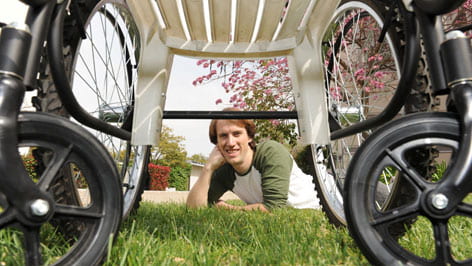A set of wheels for people in need
Just two months after Chancellor Michael Drake kicked off Free Wheelchair Mission’s 2008 national tour at UC Irvine, engineering students here were hard at work on a wheelchair prototype that would soon help people worldwide get around more easily.

Just two months after the Free Wheelchair Mission kicked off its 2008 national tour at UC Irvine, engineering students here were hard at work on a wheelchair prototype that would soon help people worldwide get around more easily.
Free Wheelchair Mission, which aims to “provide the transforming gift of mobility to the physically disabled poor in developing countries,” has distributed more than 370,000 wheelchairs to people in at least 71 nations. Its goal is 20 million.
Don Schoendorfer, president and founder, used a customized plastic lawn chair and mountain-bike tires to create an inexpensive, easy-to-assemble wheelchair that satisfies the greatest range of needs. To augment his efforts, the nonprofit partnered with UCI’s Henry Samueli School of Engineering, enlisting the aid of students in the Engineering Design in Industry course.
“The class gives students a real-world engineering experience before they leave UCI,” says Kenneth Mease, mechanical and aerospace engineering professor. “It helps connect classroom learning to engineering practice.”
The course typically matches groups of four students with company-sponsored projects, but when 10 students applied for the wheelchair venture last summer, Mease and John Garman, project co-adviser, decided to let all of them participate.
“There was a lot of enthusiasm,” says Garman. “They were excited about doing something philanthropic.”
One student, mechanical engineering senior Anthony Brock, became interested in the project after seeing Free Wheelchair Mission in action on its Web site.
“A video showed a shipment of wheelchairs being delivered to a Third World country and how the wheelchairs helped mobilize people who previously were crawling on the ground, being dragged on tarps or carried,” Brock says. “I knew we could improve the wheelchair’s quality. That’s what I hoped to contribute.”
Over 10 weeks, the students refined the wheelchair design, particularly its footrests and brakes. They generated three-dimensional computer renderings and conducted stress and fatigue tests to evaluate durability.
“It’s an amazing blessing to have the support of this world-class engineering talent,” Schoendorfer says. “The results of their studies gave us confidence to commit our full – though limited – resources to this new design.”
Based on UCI students’ drawings, a Chinese factory built a prototype, and the new model passed one of the International Organization for Standardization’s most challenging tests: The “double-drum test,” which simulates five years of use on a bumpy road, helped confirm that the new design is sturdy.
“It’s been very rewarding to work on this project,” Brock says. “I gained a lot of experience in group organization and applying engineering principles to a real-world problem.”
Though finished with the UCI course, he continues to work with Schoendorfer and the new wheelchair.
“It has been important for me to stay with it,” Brock says. “I feel I have a commitment to obtain a high-quality final product to distribute to people in need.”